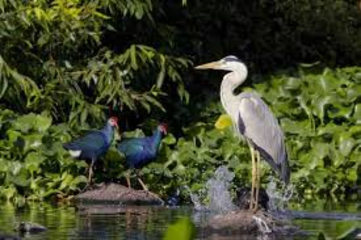After four years of derelict, here’s a piece of good news for the 22-acre Salim Ali Bird Park, located on the banks of the Mula-Mutha river at Yerawada. In January, state environment minister Aaditya Thackeray, held a meeting with civic authorities and assured all possible help. The young minister also asked the civic commissioner to promptly remove debris and deploy security measures to prevent it again. Action followed and PMC in coordination with forest department lifted over 10,000 tonnes of debris while also installing CCTVs to keep a check against anti-social activities. The minister visited the park, Sunday, and assured that a large parcel of land will now be handed over to forest department.
With number of water reservoirs and a green belt in and around Pune, the city hosts migratory birds from regions as far away as Europe, Siberia, China and Mongolia during various seasons. This haven for winged species was once frequented by the likes of Ruddy Shelduck, Red Wattled Lapwings and Black Headed Ibis.
There are many examples in the city where nallah or sewage channel has been converted into gardens. The latest step by government in the case of Salim Ali Park is crucial in that direction.
Civic apathy led to anti-social elements occupying the park, cutting and burning trees, and indulging in blatant vandalism. At the same time, unauthorised dumping of debris at the reserve grew. This choked the natural spring passing through the park which was a major source of water for the birds.
The overall effect: birds stopped visiting the park, named after ornithologist Salim Ali, who once paid a visit to the same. Locals, in a bid to save the oasis of green in the rapidly encroaching concrete change, then launched weekend cleanliness drives at the park. However, these efforts were inadequate until the government and Pune Municipal Corporation (PMC) turned its attention.
There are two plots under litigation within Salim Ali Park where a prominent developer wanted to construct a building. The Bombay High Court in 2018 ordered status quo on the construction activity on two acre of plot that was de-reserved inside the bird sanctuary. Although this offered some respite, a group of people from the Siddharthnagar slums later in 2018 claimed ownership of the bird park land as mahar watan land. The locals while admitting that their name did not exist in the land ownership papers for the plot, demanded the plot be handed over to them. While their intention in creating a commotion was seen as an attempt thwart the restoration of the bird park, the civic authorities convinced them that land belongs to bird sanctuary.
The minister has now ordered land not under litigation can be developed into thick urban forest by handing the lot to forest department. This is a welcome step given that forest department’s record of securing land in the city area has been better than the civic body. This has paved the way for the park’s restoration.
Handing over of land to the forest department is an important milestone in city wildlife conservation. Already, some bird species like grey francolin, baya weaver, citrine wagtail and pied kingfisher have lost their habitat due to the illegal dumping. These birds are known to be sensitive to their habitat and they leave a site even with a slight disturbance.
The geo-enabled tree census conducted by PMC has so far covered as many as 46 lakh trees in the city. Most of them however are from Pune’s western part known to be ecologically rich.














